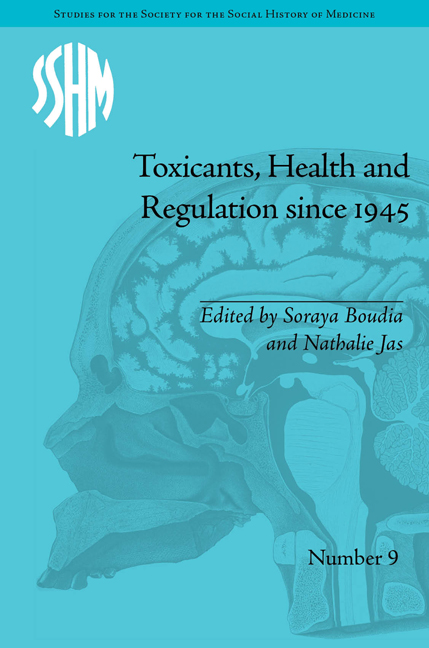Book contents
- Frontmatter
- Contents
- Acknowledgements
- List of Figures and Tables
- List of Contributors
- Introduction
- 1 The Cold War Over the Worker's Body: Cross-National Clashes Over Maximum Allowable Concentrations in the Post-World War II Era
- 2 Adapting To ‘Reality’: The Emergence of an International Expertise On Food Additives and Contaminants in the 1950s and Early 1960s
- 3 From Threshold to Risk: Exposure to Low Doses of Radiation and its Effects On Toxicants Regulation
- 4 ‘License To Expose’? Occupational Exposure Limits, Scientific Expertise and State in Contemporary France
- 5 Chemical Infrastructures of the St Clair River
- 6 Managing an Everlastingly Polluted World: Food Policies And Community Health Actions in the French West Indies
- 7 Chernobyl Empowerment? Exporting ‘Participatory Governance’ to Contaminated Territories
- Notes
- Index
3 - From Threshold to Risk: Exposure to Low Doses of Radiation and its Effects On Toxicants Regulation
- Frontmatter
- Contents
- Acknowledgements
- List of Figures and Tables
- List of Contributors
- Introduction
- 1 The Cold War Over the Worker's Body: Cross-National Clashes Over Maximum Allowable Concentrations in the Post-World War II Era
- 2 Adapting To ‘Reality’: The Emergence of an International Expertise On Food Additives and Contaminants in the 1950s and Early 1960s
- 3 From Threshold to Risk: Exposure to Low Doses of Radiation and its Effects On Toxicants Regulation
- 4 ‘License To Expose’? Occupational Exposure Limits, Scientific Expertise and State in Contemporary France
- 5 Chemical Infrastructures of the St Clair River
- 6 Managing an Everlastingly Polluted World: Food Policies And Community Health Actions in the French West Indies
- 7 Chernobyl Empowerment? Exporting ‘Participatory Governance’ to Contaminated Territories
- Notes
- Index
Summary
On 5 August 2011, the day before the Hiroshima Commemoration, Science magazine announced the start of a new and highly ambitious study: 2 million people will be monitored for at least thirty years in order to assess the effects of low doses of radioactivity. The study announced by Science concerns the entire population of the prefectural region of Fukushima, to the point where Akira Watanabe, vice-chairman of Fukushima University declared ‘We're all guineapigs.’ And indeed, for the second time in history, and willingly or not, part of the Japanese population has become an object of study for doctors and scientists. With this new epidemiological cohort, this population has sadly strengthened its position as the leading provider of data on low dose effects of radioactivity. As the United Nations Scientific Committee on the Effects of Atomic Radiation (UNSCEAR) pointed out in its last report, up until this study was announced, the data obtained from the medical monitoring of Hiroshima's and Nagasaki's populations were the main source of knowledge on the effects of exposure to low doses of radioactivity. Because the people living on the land contaminated by the Chernobyl disaster were not systematically monitored over a long period, over coming years the Fukushima data on low dose effects of radioactivity might provide crucial information to complement data gathered from monitoring survivors of the Hiroshima and Nagasaki bombings over recent decades.
- Type
- Chapter
- Information
- Toxicants, Health and Regulation since 1945 , pp. 71 - 88Publisher: Pickering & ChattoFirst published in: 2014



